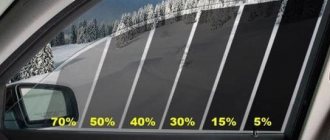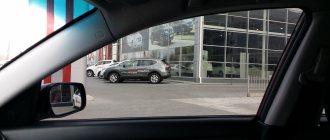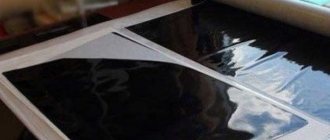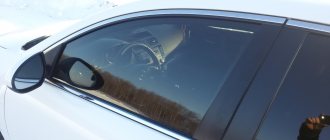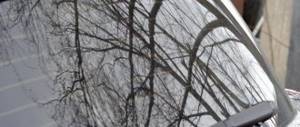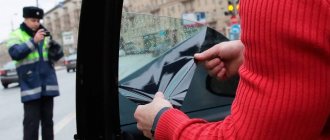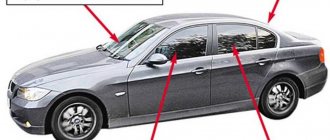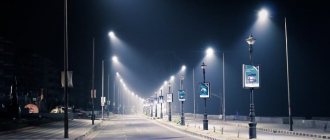Traffic regulations on tinting:
In clause 7.3. “The list of faults and conditions under which the operation of the vehicle is prohibited” (Appendix to the Traffic Rules) states that the operation of the vehicle is prohibited if:
Additional objects have been installed or coatings have been applied that restrict visibility from the driver's seat.
Note. Transparent colored films can be attached to the top of the windshield of cars and buses. It is allowed to use tinted glass (except for mirror glass), the light transmission of which complies with GOST 5727-88. It is allowed to use curtains on the windows of tourist buses, as well as blinds and curtains on the rear windows of passenger cars if there are external rear-view mirrors on both sides.
Rules for measuring tinting
It is stipulated that the device operates from a cigarette lighter, which has a voltage of 12 volts with a possible deviation in both directions of no more than 0.6 volts.
It is stipulated that the driver himself is allowed not to allow the inspector to use the cigarette lighter in his car if it is in a faulty condition.
The taumeter device must be equipped with a seal, which must maintain its integrity at the time of measurement. It requires the presence of a tag on which the date of the next verification of the device is written.
Along with directly determining the light transmittance of a window, the inspector is required to perform a number of other actions, which the car owner, in turn, has the right to demand from him.
It has been established that during the procedure the following must be done:
| Present the device to the car owner for personal inspection | In order to allow him to make sure that the taumeter has an intact seal and has no external defects |
| Present to the car owner whose glass is being checked | A document that confirms that the device meets the requirements of GOST; in the absence of this paper, the car owner asks to enter this circumstance into the protocol |
| Show documents to the car owner | About the tests (verification) carried out in relation to this device, its use is possible only if the error rate for it is no more than 2%, and the last verification should take place no more than a year before the actual measurement |
| Measure | Temperature, pressure and humidity indicators |
| Show documents to the driver | Confirming that the instruments used to measure the indicators mentioned in the previous paragraph also comply with GOST |
| To the person taking the measurement | It is necessary to present a document that indicates that he himself knows how to properly take measurements using a taumeter |
It is in the presence of all the documents given in this list that the measurement of tinting according to GOST will have evidentiary force.
Features of checking car windows
Vehicle window tinting is done for several purposes. Firstly, it gives the car a more attractive appearance. Secondly, the tint film protects appliances and upholstery from direct sunlight. And finally, proper tinting of a car increases safety, because... reduces the effect of driver blinding by the sun and headlights of oncoming cars at night. To control owners who excessively tint their cars, a special GOST was introduced. Let's look at what tinting of front windows is allowed according to GOST in 2017-2018.
For tinting the windows of your car, contact the KVM-KO auto studio.
GOST 5727-88 about tinting:
(this GOST has become invalid since 01/01/2015)
Clause 2.2.4. The light transmission of glass providing visibility to the driver must be no less than:
75% - for windshields;
70% - for glasses that are not windshields, included in the standard field of view P, which determines forward visibility
See picture
Permitted tinting, GOST
In 2021, GOST 32565-2013 (dated 01/01/2015) is in force, the old GOST 5727-88 is no longer valid.
According to the new GOST 32565-2013, Safety glass for land transport: 5.1.2.5 The light transmission of glass that provides visibility to the driver from the front must be at least 70% for windshields and for glasses that are not windshields, but provide visibility to the driver in front and behind. If two external rear-view mirrors are installed on a vehicle, the light transmission of the glass that provides the driver's rear view is not standardized. The width of shading strips on windshields for vehicles of categories GOST 32565-2013 should not be more than 140 mm.
Technical regulations on the safety of wheeled vehicles on tinting:
Appendix No. 5 to the Technical Regulations:
"3.5.2. The light transmission of the windshield, front side windows and front door windows (if equipped) must be at least 70 percent.
3.5.3. In the upper part of the windshield of vehicles of categories M1, M2 and N1, it is allowed to mount a strip of transparent color film with a width of no more than 140 mm, and on vehicles of categories M3, N2 and N3 - with a width not exceeding the minimum distance between the upper edge of the windshield and the upper border zones for cleaning it with a windshield wiper. In this case, the light transmission requirements established in paragraph 3.5.2 must be met.”
Note: Category M - vehicles that have at least four wheels and are used for the transportation of passengers Passenger cars, including: Category M1 - vehicles used for the transportation of passengers and having, in addition to the driver's seat, no more than eight seats. Buses, trolleybuses, specialized passenger vehicles and their chassis, including: Category M2 – vehicles used for the transport of passengers, having, in addition to the driver’s seat, more than eight seats, the technically permissible maximum weight of which does not exceed 5 tons. Category M3 – vehicles used for the transport of passengers, having, in addition to the driver’s seat, more than eight seats, the technically permissible maximum weight of which exceeds 5 tons.
Category N - vehicles used for the transportation of goods - trucks and their chassis, including: Category N1 - vehicles intended for the transportation of goods, having a technically permissible maximum weight of no more than 3.5 tons. Category N2 – vehicles intended for the transportation of goods, having a technically permissible maximum weight of over 3.5 tons, but not more than 12 tons. Category N3 – vehicles intended for the transportation of goods, having a technically permissible maximum weight of more than 12 tons.
All about tinting 2021: current innovations and some nuances
Effective January 1, 2021, the Legislature intends to increase penalties for exceeding tinting levels. Current legislation regulates the light transmission standards of vehicle windows. Window tinting is permissible if the following conditions are met:
- The light transmittance of the front and side panels is not lower than 70%.
- The light transmittance for the windshield is set at 75%.
If the car windows do not meet these requirements, the car owner will pay a fine. In 2021, “wrong” tinting will cost the car owner 1,500 rubles.
The draft new law on tinting involves a significant increase in the amount of fines in 2021 and a transition to a progressive system of sanctions. For the first violation, the fine will be 1.5 thousand rubles. Subsequent violations will cost significantly more – 5 thousand rubles.
In 2021, amendments were made to the Code of Administrative Offenses of the Russian Federation and the Traffic Regulations, known to the public as the new law on tinting of July 1, 2021, according to which the punishment of vehicle drivers has changed slightly. In particular, amendments were made to the articles of the law on tinting, which regulates the correct operation of the car: a ban was established on tinted windows that do not comply with established norms and rules.
Changes in legislation occurred on the basis of the Federal Law of October 14, 2014 No. 307-FZ “On Amendments to the Code of the Russian Federation on Administrative Offenses.”
In Part 3.1 of Art. 12.5 of the Code of Administrative Offenses (as amended on June 8, 2015 N 143-FZ) states that (for 2021) the fine was 500 rubles.
Extract from the law: 3.1. Driving a vehicle on which glass is installed, the light transmission of which does not meet the requirements of the technical regulations on the safety of wheeled vehicles, entails the imposition of an administrative fine in the amount of five hundred rubles.
Since this amount is insignificant, the Ministry of Internal Affairs plans to submit a bill on tinting to tighten penalties for violating the rules. There are also plans to ban the use of super-tinted glass.
Such amendments to the Code of Administrative Offenses provide for an increase in fines to 5,000 rubles (for repeated violations). Deprivation of rights for up to 6 months (as a method of pressure) was considered, but not approved. They are planning to consider the bill. Amendments to the draft will concern Part 3.1 of Art. 12.5 of the Administrative Code of Russia.
Another news for drivers this year was the easing of penalties, thanks to amendments to Art. 27.13 Code of Administrative Offenses of the Russian Federation. According to the order, the cancellation of the removal of state licenses has been established. license plates from the car for violating tinting rules.
Conclusion:
The front windshield (windshield), front side windows and front door windows (if equipped) must have a light transmittance of at least 70%.
The light transmittance of the rear and rear side windows is not standardized (BUT! If there are external rear-view mirrors on both sides).
Tinting with a mirror effect is prohibited.
Comments
Alexander 06/21/2016 14:48 + if an additional coating is applied to the glass, you need a test certificate for chemical resistance, fire resistance, etc.
and so on. in the same guest it is mentioned about polymer coatings. Reply | Reply with quote | Quote
Yakov 08/05/2016 02:46 And if, for example, on a microtruck the left side mirror is not used at all for the mirror, can it be tinted? Should I leave a cutout on the right side for the rear view mirror? (it’s just very hot to drive, the air conditioning can’t handle it in the sun)
Reply | Reply with quote | Quote
Update list of comments
Is there permission for tinting?
There is a persistent rumor among drivers that it is necessary to obtain special permission to tint a car. In fact, there is no special document that allows a driver to tint a car. This type of tuning does not even require documentary registration with the traffic police. Although some experts are inclined to believe that tinting does affect safety and should be considered a change in the design of the car.
The fact is that glass is made with safety in mind in case of accidents. If a car gets into an accident, the front glass should not crumble into fragments; for this, triplex is made, with a polymer film placed between the two layers. The side glass, on the contrary, crumbles into small cubes that do not have sharp edges. If you cover the glass with tinting, theoretically its characteristics will change, which means that in the event of an accident there is a risk of injury to the driver and passengers.
In practice, even after passing the Technical Inspection, questions regarding tinting do not arise. If it is made in accordance with GOST.
Quality control in the Eurasian Economic Union
One of the main problems that the EAEU member countries had to solve during the formation of the union and the intensification of mutual trade processes was the implementation of quality control of goods. At that time, national rules were in force in each state that was part of the association. Therefore, entry into the national market of goods manufactured in other countries was difficult for formal reasons.
The solution to this difficult task was the introduction of uniform quality standards, which began to apply in all states that are members of the EAEU. Such standards are created separately for each group of goods and are prescribed in a special regulatory document - technical regulations. From the moment it comes into force, compliance with such standards becomes mandatory for all manufacturers of such products operating in the territory of the Union. At the same time, having once passed the procedure for assessing compliance with technical regulations, they can manufacture, transport, sell their goods and perform other operations with them without issuing additional permits in each EAEU member country.
Innovations
The vehicle technical regulations contain some innovations in the field of vehicle safety, the main ones being:
- Establishment of mandatory yellow color for direction indicators.
- Xenon ban. The car owner cannot use gas-discharge light sources without the use of automatic headlight levelers. Failure of correctors is also considered a direct violation of the requirements of the regulatory act.
- It is prohibited to attach protruding structures made of steel or materials with similar properties to the front part or bumpers of cars of categories N1, G and M1.
Also, the Technical Regulations of the vehicle establish quite strict requirements for wind light transmission, front door windows, side and front windows. The standard for light transmission of windows is 70% (these requirements do not apply to cars of category M). Before this regulation came into force, it was possible to use a darkening film that had any level of light transmittance. However, studies have shown that some types of film (low transmittance) impair vision. That's why they are now banned. But the technical regulations of wheeled vehicles do not prohibit the use of mirror tinting.
What are vehicle technical regulations?
The safety requirements and standards for cars of categories O, N, M and L are established by the Technical Regulations of Wheeled Vehicles
, approved by Decree of the Government of the Russian Federation No. 720 of September 10, 2009. This resolution came into force on September 23, 2010. The approved regulatory act contains mandatory standards for application and execution to ensure vehicle safety, as well as requirements for the procedure for confirming compliance with these standards.
Permitted tinting
regulated by Decree of the Government of the Russian Federation dated December 5, 2011 N 1008 (as amended on November 3, 2015) “On technical inspection of vehicles”
Visibility requirements
4.1. The vehicle must be equipped with glass provided by the manufacturer. 4.2. It is not allowed to have additional objects or coverings that limit visibility from the driver’s seat (with the exception of rear-view mirrors, parts of windshield wipers, external and radio antennas applied or built into the glass, heating elements of windshield defrosting and drying devices). 4.3. The light transmission of the windshield and windows through which forward visibility is provided to the driver must be at least 70%. This requirement does not apply to the rear windows of vehicles of category M1, provided that the vehicle is equipped with external rear-view mirrors that meet the requirements of this annex. At the top of the windshield, it is allowed to have a light-protective strip made in the bulk of the glass, or to attach a light-protective strip of a transparent color film with a width of no more than 140 mm, and on vehicles of categories M3, N2 and N3 - with a width not exceeding the minimum distance between the upper edge of the windshield and the upper boundary of the area where it is cleaned with a windshield wiper. If the tinting is done in the bulk of the glass, the width of the shading strip must correspond to that established by the vehicle manufacturer. The light transmittance of the light protection strip is not standardized. 4.4. Painted and tinted windshields must not distort the correct perception of white, yellow, red, green and blue. 4.5. It is not allowed to use glass whose coating creates a mirror effect. 4.6. Curtains are permitted on the side and rear windows of vehicles of category M3 class III. Decree of the State Standard of the Russian Federation No. 363 dated July 1, 1999 allows you to independently tint car windows in various ways. Please tint, but remember that after tinting, light transmission should be within normal limits (see above). Keep in mind that a new car windshield absorbs up to 20% of the light output. And dirty and old, worn-out absorbs 25-30% of the light flux. Therefore, even sticking a transparent film on the windshield does not fall within the limits of permitted tinting.


